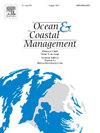From compound climate risks to adaptive governance: Sectoral economic exposure to heat-drought compound events in coastal China
IF 4.8
2区 环境科学与生态学
Q1 OCEANOGRAPHY
引用次数: 0
Abstract
Compound extremes, such as heat-drought compound extremes (HDCEs), are intensifying with climate change, posing escalating risks to coastal economies. In coastal China, where rapid socioeconomic development intersects with increasing climate hazards, coastal governance faces growing challenges in managing such compound risks. However, limited research has quantified the economic exposure to HDCEs under various warming scenarios, which is crucial for guiding adaptive governance and sustainable coastal development. This study quantifies sectoral economic exposure to HDCEs under 1.5 °C, 2.0 °C, and 3°0 C global warming scenarios, using multi-model climate ensemble and gross domestic product (GDP) projections from the SSP-RCP framework. Results show that total GDP exposure in coastal China in three warming scenarios will increase by 12.54 ± 0.63, 15.38 ± 1.83, and 61.64 ± 8.73 times, respectively, relative to the base period (1995–2014). Notably, northern coastal China exhibits much higher exposure than eastern and southern regions, and the tertiary sector is projected to face the largest increase, reaching up to 125.05 ± 17.70 times under the 3.0 °C scenario. The dominant contribution (48 %–71 %) to exposure increase stems from the interactive effect between climate and GDP change. By linking these findings to sustainable development goals (SDGs) like SDG8 (Decent work and economic growth) and SDG13 (Climate action), this study provides actionable insights for strengthening adaptive coastal governance. We underscore the urgency of prioritizing the tertiary sector and high-exposure regions in climate adaptation plans. These results contribute to the growing body of scholarship that supports climate-resilient, sector-specific, and globally relevant coastal governance strategies.
从复合气候风险到适应性治理:中国沿海地区高温干旱复合事件对行业经济的影响
随着气候变化,诸如高温干旱复合极端天气(HDCEs)等复合极端天气正在加剧,给沿海经济带来越来越大的风险。在中国沿海地区,快速的社会经济发展与日益增加的气候灾害交织在一起,沿海治理在管理这些复合风险方面面临着越来越大的挑战。然而,有限的研究已经量化了各种变暖情景下hdce的经济风险,这对于指导适应性治理和可持续沿海发展至关重要。本研究利用多模式气候集合和来自SSP-RCP框架的国内生产总值(GDP)预测,量化了在1.5°C、2.0°C和3°0 C全球变暖情景下,部门经济对hdce的暴露程度。结果表明,在3种变暖情景下,中国沿海地区GDP暴露总量将分别比基期(1995-2014)增加12.54±0.63倍、15.38±1.83倍和61.64±8.73倍。值得注意的是,中国北部沿海地区的受影响程度远高于东部和南部地区,预计第三产业将面临最大的增长,在3.0°C情景下将达到125.05±17.70倍。暴露增加的主要贡献(48% - 71%)来自气候和GDP变化之间的相互作用。通过将这些发现与可持续发展目标(sdg)(体面工作和经济增长)和可持续发展目标(SDG13)(气候行动)等可持续发展目标(sdg)联系起来,本研究为加强适应性沿海治理提供了可行的见解。我们强调在气候适应计划中优先考虑第三产业和高风险地区的紧迫性。这些结果为支持气候适应型、特定行业和全球相关的沿海治理战略的学术研究做出了贡献。
本文章由计算机程序翻译,如有差异,请以英文原文为准。
求助全文
约1分钟内获得全文
求助全文
来源期刊

Ocean & Coastal Management
环境科学-海洋学
CiteScore
8.50
自引率
15.20%
发文量
321
审稿时长
60 days
期刊介绍:
Ocean & Coastal Management is the leading international journal dedicated to the study of all aspects of ocean and coastal management from the global to local levels.
We publish rigorously peer-reviewed manuscripts from all disciplines, and inter-/trans-disciplinary and co-designed research, but all submissions must make clear the relevance to management and/or governance issues relevant to the sustainable development and conservation of oceans and coasts.
Comparative studies (from sub-national to trans-national cases, and other management / policy arenas) are encouraged, as are studies that critically assess current management practices and governance approaches. Submissions involving robust analysis, development of theory, and improvement of management practice are especially welcome.
 求助内容:
求助内容: 应助结果提醒方式:
应助结果提醒方式:


